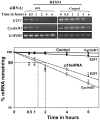p16( INK4a) positively regulates cyclin D1 and E2F1 through negative control of AUF1
- PMID: 21799732
- PMCID: PMC3140473
- DOI: 10.1371/journal.pone.0021111
p16( INK4a) positively regulates cyclin D1 and E2F1 through negative control of AUF1
Abstract
Background: The cyclin-D/CDK4,6/p16(INK4a)/pRB/E2F pathway, a key regulator of the critical G1 to S phase transition of the cell cycle, is universally disrupted in human cancer. However, the precise function of the different members of this pathway and their functional interplay are still not well defined.
Methodology/principal findings: We have shown here that the tumor suppressor p16(INK4a) protein positively controls the expression of cyclin D1 and E2F1 in both human and mouse cells. p16(INK4a) stabilizes the mRNAs of the corresponding genes through negative regulation of the mRNA decay-promoting AUF1 protein. Immunoprecipitation of AUF1-associated RNAs followed by RT-PCR indicated that endogenous AUF1 binds to the cyclin D1 and E2F1 mRNAs. Furthermore, AUF1 down-regulation increased the expression levels of these genes, while concurrent silencing of AUF1 and p16(INK4a), using specific siRNAs, restored normal expression of both cyclinD1 and E2F1. Besides, we have shown the presence of functional AU-rich elements in the E2F1 3'UTR, which contributed to p16/AUF1-mediated regulation of E2F1 post-transcriptional events in vivo. Importantly, genome-wide gene expression microarray analysis revealed the presence of a large number of genes differentially expressed in a p16(INK4a) -dependent manner, and several of these genes are also members of the AUF1 and E2F1 regulons. We also present evidence that E2F1 mediates p16-dependent regulation of several pro- and anti-apoptotic proteins, and the consequent induction of spontaneous as well as doxorubicin-induced apoptosis.
Conclusion/significance: These findings show that the cyclin-dependent kinase inhibitor p16( INK4a) is also a modulator of transcription and apoptosis through controlling the expression of two major transcription regulators, AUF1 and E2F1.
Conflict of interest statement
Figures









Similar articles
-
p16(INK4A) positively regulates p21(WAF1) expression by suppressing AUF1-dependent mRNA decay.PLoS One. 2013 Jul 23;8(7):e70133. doi: 10.1371/journal.pone.0070133. Print 2013. PLoS One. 2013. PMID: 23894605 Free PMC article.
-
Hydrogen peroxide induces p16(INK4a) through an AUF1-dependent manner.J Cell Biochem. 2010 Apr 1;109(5):1000-5. doi: 10.1002/jcb.22474. J Cell Biochem. 2010. PMID: 20069554
-
The cytokine IL-6 reactivates breast stromal fibroblasts through transcription factor STAT3-dependent up-regulation of the RNA-binding protein AUF1.J Biol Chem. 2014 Nov 7;289(45):30962-76. doi: 10.1074/jbc.M114.594044. Epub 2014 Sep 17. J Biol Chem. 2014. PMID: 25231991 Free PMC article.
-
Physiological networks and disease functions of RNA-binding protein AUF1.Wiley Interdiscip Rev RNA. 2014 Jul-Aug;5(4):549-64. doi: 10.1002/wrna.1230. Epub 2014 Mar 28. Wiley Interdiscip Rev RNA. 2014. PMID: 24687816 Review.
-
Alterations of pRb1-cyclin D1-cdk4/6-p16(INK4A) pathway in endometrial carcinogenesis.Cancer Lett. 2004 Jan 8;203(1):1-12. doi: 10.1016/j.canlet.2003.09.012. Cancer Lett. 2004. PMID: 14670612 Review.
Cited by
-
Effects of the p16/cyclin D1/CDK4/Rb/E2F1 pathway on aberrant lung fibroblast proliferation in neonatal rats exposed to hyperoxia.Exp Ther Med. 2021 Oct;22(4):1057. doi: 10.3892/etm.2021.10491. Epub 2021 Jul 26. Exp Ther Med. 2021. PMID: 34434271 Free PMC article.
-
A Multi-Locus Genetic Risk Score for Primary Open-Angle Glaucoma (POAG) Variants Is Associated with POAG Risk in a Mediterranean Population: Inverse Correlations with Plasma Vitamin C and E Concentrations.Int J Mol Sci. 2017 Nov 1;18(11):2302. doi: 10.3390/ijms18112302. Int J Mol Sci. 2017. PMID: 29104244 Free PMC article.
-
Exploring the RNA world in hematopoietic cells through the lens of RNA-binding proteins.Immunol Rev. 2013 May;253(1):290-303. doi: 10.1111/imr.12048. Immunol Rev. 2013. PMID: 23550653 Free PMC article. Review.
-
An Integrated Molecular Analysis of Lung Adenocarcinomas Identifies Potential Therapeutic Targets among TTF1-Negative Tumors, Including DNA Repair Proteins and Nrf2.Clin Cancer Res. 2015 Aug 1;21(15):3480-91. doi: 10.1158/1078-0432.CCR-14-3286. Epub 2015 Apr 15. Clin Cancer Res. 2015. PMID: 25878335 Free PMC article.
-
5-aza-2'-deoxycytidine, a DNA methylation inhibitor, attenuates hyperoxia-induced lung fibrosis via re-expression of P16 in neonatal rats.Pediatr Res. 2018 Mar;83(3):723-730. doi: 10.1038/pr.2017.291. Epub 2017 Dec 20. Pediatr Res. 2018. PMID: 29166374
References
-
- Vogelstein B, Kinzler KW. Cancer genes and the pathways they control. Nat Med. 2004;10:789–799. - PubMed
-
- Nevins JR. The Rb/E2F pathway and cancer. Hum Mol Genet. 2001;10:699–703. - PubMed
-
- Kaye FJ. RB and cyclin dependent kinase pathways: defining a distinction between RB and p16 loss in lung cancer. Oncogene. 2002;21:6908–6914. - PubMed
-
- Giacinti C, Giordano A. RB and cell cycle progression. Oncogene. 2006;25:5220–5227. - PubMed
MeSH terms
Substances
LinkOut - more resources
Full Text Sources
Research Materials

